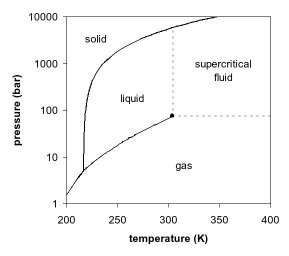Carbon dioxide flooding
Carbon dioxide (CO2) flooding is a process whereby carbon dioxide is injected into an oil reservoir in order to increase output when extracting oil.

When a reservoir’s pressure is depleted through primary and secondary production, Carbon Dioxide flooding can be an ideal tertiary recovery method. It is particularly effective in reservoirs deeper than 2,500 ft., where CO2 will be in a supercritical state, with API oil gravity greater than 22–25° and remaining oil saturations greater than 20%. It should also be noted that Carbon dioxide flooding is not affected by the lithology of the reservoir area, but simply by the reservoir porosity and permeability, so that it is viable in both sandstone and carbonate reservoirs. Carbon dioxide flooding works on the physical phenomenon that by injecting CO2 into the reservoir, the viscosity of any hydrocarbon will be reduced and hence will be easier to sweep to the production well.
As an oil field matures and production rates decline, there is growing incentive to intervene and attempt to increase oil output, via tertiary recovery techniques (also called improved or enhanced oil recovery). Petroleum Engineers will assess the available options - generally chemical injection, thermal/steam injection, or CO2 injection. After gathering information and running simulations, the engineers will determine whether CO2 is the optimal solution to increase oil production rates. To increase the rate of oil production, engineers must increase the amount of pressure within the reservoir.
In the case of CO2 flooding, the first step is to inject water into the reservoir, which will cause the reservoir pressure to increase. Once the reservoir has sufficient pressure, the next step is to pump the CO2 down through the same injection wells. The CO2 gas is forced into the reservoir and is required to come into contact with the oil. This creates this miscible zone that can be moved more easily to the production well. Normally the CO2 injection is alternated with more water injection and the water acts to sweep the oil towards the production zone.
CO2 flooding is the second most common tertiary recovery technique and is used in facilities around the world. In the scope of global warming, it is an available method to sequester CO2 underground thus offsetting some CO2 emissions elsewhere.
References
External links
- Mississippi Oil Journal Map Oil Well Map of EOR CO2 field in Brookhaven Mississippi
- Enhanced Oil Recovery Institute Enhanced Oil Recovery Institute